| Виртуальный Владимир » Город Владимир » Old Russian Towns » Bogolyubovo » Palace cathedral |
 ...
... Road to Bogolyubovo
Road to Bogolyubovo Old township of Bogolyubovo
Old township of Bogolyubovo Palace cathedral
Palace cathedral Staircase tower and passage
Staircase tower and passage Reconstruction of the palace
Reconstruction of the palace Church of the Intercession on the Nerl
Church of the Intercession on the NerlLittle has remained of the ensemble. It would seem that after the death of Andrei his residence at Bogolyubovo ceased to be of interest to the Vladimir princes. It was sacked and looted for the first time in 1177 by Prince Gleb of Ryazan, and later the invading Mongol hordes razed its fortified walls to the ground. It is likely that the palace buildings were also severely damaged, their stone being used later by the monastery for the erection of new buildings. On the southern edge of the wall stands the Church of the Annunciation, built in 1683 and considerably disfigured by alterations carried out in 1804. Legend has it that the Church of St. Leontius was built by Andrei on this spot. Next to it is a seventeenth-century chapel which, as we shall see later, does in fact stand on the ruins of one of the most interesting buildings in the old residence.
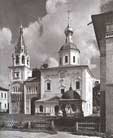 The palace's Cathedral of the Nativity of Our Lady remained intact until the end of the seventeenth century. It is described in a chronicle written by the abbot of the monastery, Aristarkh who also describes its sad fate. Apparently the ignorant Abbot Ippolit wanted to have more light in the church and ordered huge windows to be let into the walls, as a result of which the building collapsed in 1722. Fortunately part of its north walls remained intact, supported by an old passageway connecting it to the staircase tower. These remains were carefully preserved, as this was the sacred spot on which Prince Andrei was murdered. The rest of the cathedral was demolished and the present church was built on its foundations in 1751. Looking at its west wall we can easily distinguish the old structures by their bands of blind arcading and narrow windows, which we have already noted in Vladimir's buildings. The west front of the new cathedral is decorated with carved lions' masks from the old building.
The palace's Cathedral of the Nativity of Our Lady remained intact until the end of the seventeenth century. It is described in a chronicle written by the abbot of the monastery, Aristarkh who also describes its sad fate. Apparently the ignorant Abbot Ippolit wanted to have more light in the church and ordered huge windows to be let into the walls, as a result of which the building collapsed in 1722. Fortunately part of its north walls remained intact, supported by an old passageway connecting it to the staircase tower. These remains were carefully preserved, as this was the sacred spot on which Prince Andrei was murdered. The rest of the cathedral was demolished and the present church was built on its foundations in 1751. Looking at its west wall we can easily distinguish the old structures by their bands of blind arcading and narrow windows, which we have already noted in Vladimir's buildings. The west front of the new cathedral is decorated with carved lions' masks from the old building.
By piecing together all the information from written sources and excavation work we can reconstruct a picture of the twelfth-century palace.
The cathedral stood in the centre of the palace complex. Prince Andrei's close friend and spiritual adviser, the priest Mikula, in his deeply moving account of the Prince's murder gives a rapt description of the cathedral's rich decoration, its "gold" floors, its portals and doors decorated with bands of "gold", and its precious church-plate. Mikula tells us that the prince fully appreciated the power of art and used to have guests and envoys from Kiev, Byzantium and the West taken up to choir-gallery of the cathedral to admire its beauty and sumptuousness which bore eloquent witness to the power of the Vladimir ruler. Six centuries later Abbot Aristarkh noted that the cathedral was exactly like the Church of the Intercession on the Nerl. He also mentioned its unusual circular pillars with huge "crowns". All this was held to be pure invention or exaggeration, until excavation work carried out in 1934-1938 proved it to be very close to the truth.
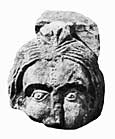
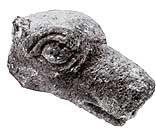 Let us now enter the western building adjoining the church. In front of us we see the lower part of the 1158 cathedral's west wall, with its magnificently finished attic plinth and powerful pilasters with semi-columns resting on Romanesque bases with griffins at the corners. In the centre is a portal, whose shape is already familiar to us. Its columns bear the imprint of nails underneath which there are tiny pieces of thin gilded copper, showing that it really was decorated with bands of something resembling gold. Excavations also revealed stone carvings from the outside of the old cathedral — fragments of magnificent capitals decorated with leaves and female masks showing that the cathedral was dedicated to the Virgin Mary. The masks were varied, some of them showing the calm,delicated features of a young girl, and others full of tension and concentration, expressed very economically by a line in the forehead and deep-set eyes. Of the stone gargoyles between the zakomaras, a round piece of sculpture has been found representing the head of a dog or dragon which decorated the upper part of the pipe.
Let us now enter the western building adjoining the church. In front of us we see the lower part of the 1158 cathedral's west wall, with its magnificently finished attic plinth and powerful pilasters with semi-columns resting on Romanesque bases with griffins at the corners. In the centre is a portal, whose shape is already familiar to us. Its columns bear the imprint of nails underneath which there are tiny pieces of thin gilded copper, showing that it really was decorated with bands of something resembling gold. Excavations also revealed stone carvings from the outside of the old cathedral — fragments of magnificent capitals decorated with leaves and female masks showing that the cathedral was dedicated to the Virgin Mary. The masks were varied, some of them showing the calm,delicated features of a young girl, and others full of tension and concentration, expressed very economically by a line in the forehead and deep-set eyes. Of the stone gargoyles between the zakomaras, a round piece of sculpture has been found representing the head of a dog or dragon which decorated the upper part of the pipe.
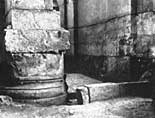
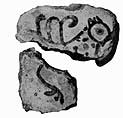 Let us now enter the cathedral and look at its excavated southern section. The pillars of the new building rest on old circular pillars with attic plinths. Their columns were painted to look like white marble and topped with huge gilded capitals decorated with leaves, similar to the "crowns" described by Aristarkh. Nothing remains of the cathedral's old floor, but excavations revealed its lime base with the greenish out lines left by large, rectangular slabs of bronze soldered together with tin. Fragments of the slabs have also been found. When highly polished they would have looked like gold. Some stones from the altar screen have survived by the southeast pillar. The screen was quite low and over its arches you could see the gilded peaked canopy above the altar. This beautiful canopy is described by the chronicler as being "devised with great skill". In the layers of rubble left over after the old cathedral was demolished, there are clusters of tiny fragments of the frescoes which covered its walls and ceiling. As far as we can tell from these, the frescoes were painted in restrained, subtle colours with a predominance of ochre, green and blue shades. The figures of the saints appeared in arched frames with acanthus leaf decoration linking the cathedral's painting with its architecture, as in the Cathedral of the Assumption at Vladimir. Among the rubble in the western third of the cathedral many fragments of majolica tiles were found from the floor of the choir-gallery, some of which were decorated with strange beasts and flowers. The shining bronze floor of the cathedral and the smooth surface of the majolica tiles reflected the shafts of light falling through the windows in the walls and drum and the glow of the candles in the rich chandeliers. The beauty of the interior was further enhanced by sumptuous altar cloths and the abundant gold and silver plate. In the west side of the north wall we can still see the old arch of the entrance to the choir-gallery. The gallery was placed high up and from here the interior of the cathedral, bathed in light and glowing with colour from the frescoes, would have created an impression of extraordinary spaciousness and soaring motion. The Prince did, indeed, have something to be proud of, and there was plenty for the envoys and guests from foreign lands to admire.
Let us now enter the cathedral and look at its excavated southern section. The pillars of the new building rest on old circular pillars with attic plinths. Their columns were painted to look like white marble and topped with huge gilded capitals decorated with leaves, similar to the "crowns" described by Aristarkh. Nothing remains of the cathedral's old floor, but excavations revealed its lime base with the greenish out lines left by large, rectangular slabs of bronze soldered together with tin. Fragments of the slabs have also been found. When highly polished they would have looked like gold. Some stones from the altar screen have survived by the southeast pillar. The screen was quite low and over its arches you could see the gilded peaked canopy above the altar. This beautiful canopy is described by the chronicler as being "devised with great skill". In the layers of rubble left over after the old cathedral was demolished, there are clusters of tiny fragments of the frescoes which covered its walls and ceiling. As far as we can tell from these, the frescoes were painted in restrained, subtle colours with a predominance of ochre, green and blue shades. The figures of the saints appeared in arched frames with acanthus leaf decoration linking the cathedral's painting with its architecture, as in the Cathedral of the Assumption at Vladimir. Among the rubble in the western third of the cathedral many fragments of majolica tiles were found from the floor of the choir-gallery, some of which were decorated with strange beasts and flowers. The shining bronze floor of the cathedral and the smooth surface of the majolica tiles reflected the shafts of light falling through the windows in the walls and drum and the glow of the candles in the rich chandeliers. The beauty of the interior was further enhanced by sumptuous altar cloths and the abundant gold and silver plate. In the west side of the north wall we can still see the old arch of the entrance to the choir-gallery. The gallery was placed high up and from here the interior of the cathedral, bathed in light and glowing with colour from the frescoes, would have created an impression of extraordinary spaciousness and soaring motion. The Prince did, indeed, have something to be proud of, and there was plenty for the envoys and guests from foreign lands to admire.
The cathedral now contains a collection of items found during excavations. There is a four-headed capital from the cathedral's narthex which is mentioned in the chronicle. This probably took the form of an open portico in front of the west portal which led into the palace courtyard. Its arches rested on two corner columns with four-headed capitals. The items also include an extremely rare specimen of Russian twelfth-century writing - a stone cross with a carved inscription of praise of the cross, which originally stood at the mouth of the Nerl as a warning of the shallows and sand-banks where it joined the Klyazma.
Now let us go through the north portal and stop in the covered passageway. On our left is part of the old wall of the cathedral and under the arch we can see the wedge-shaped consoles of its band of blind arcading and part of the semi-column of a pilaster. It follows that the cathedral was completely decorated on this side even though an entrance to the choir-gallery had already been made above the band of blind arcading, and the craftsmen knew full well that the small columns of the band would be concealed by the passage which was to be built on.
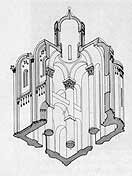 The plan of the cathedral can be reconstructed from information obtained from chronicles and excavations.
The plan of the cathedral can be reconstructed from information obtained from chronicles and excavations.
Оставить комментарий:



 Виртуальный Владимир
Виртуальный Владимир Область
Область Панорамы города
Панорамы города Организации
Организации Улицы и дома
Улицы и дома Добавить организацию
Добавить организацию О городе
О городе










